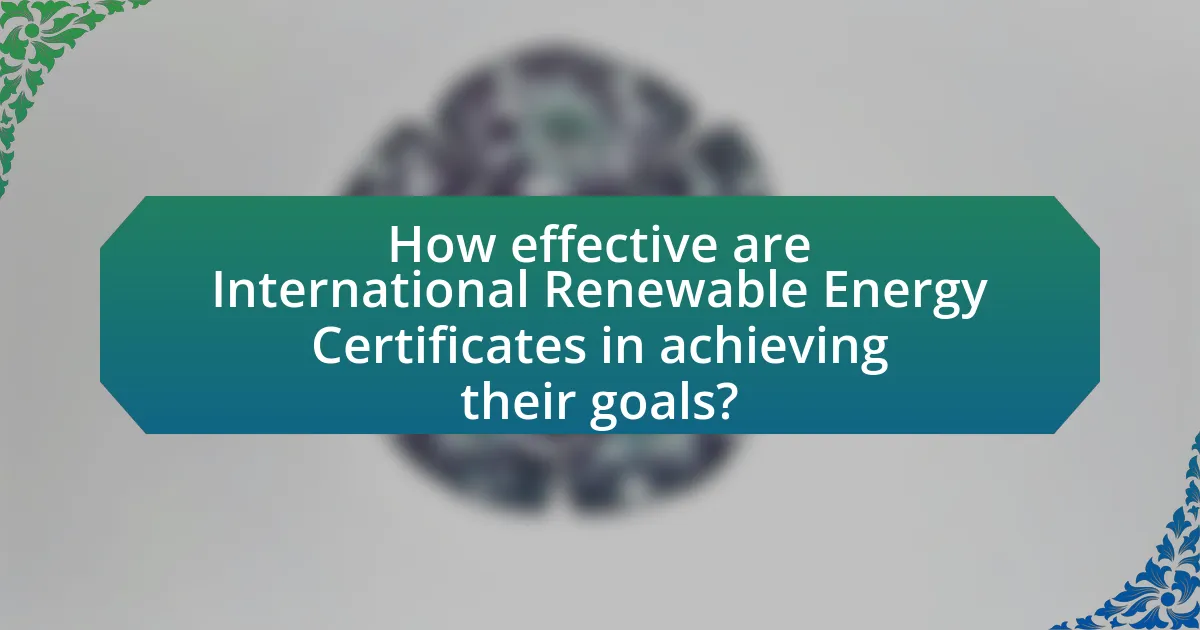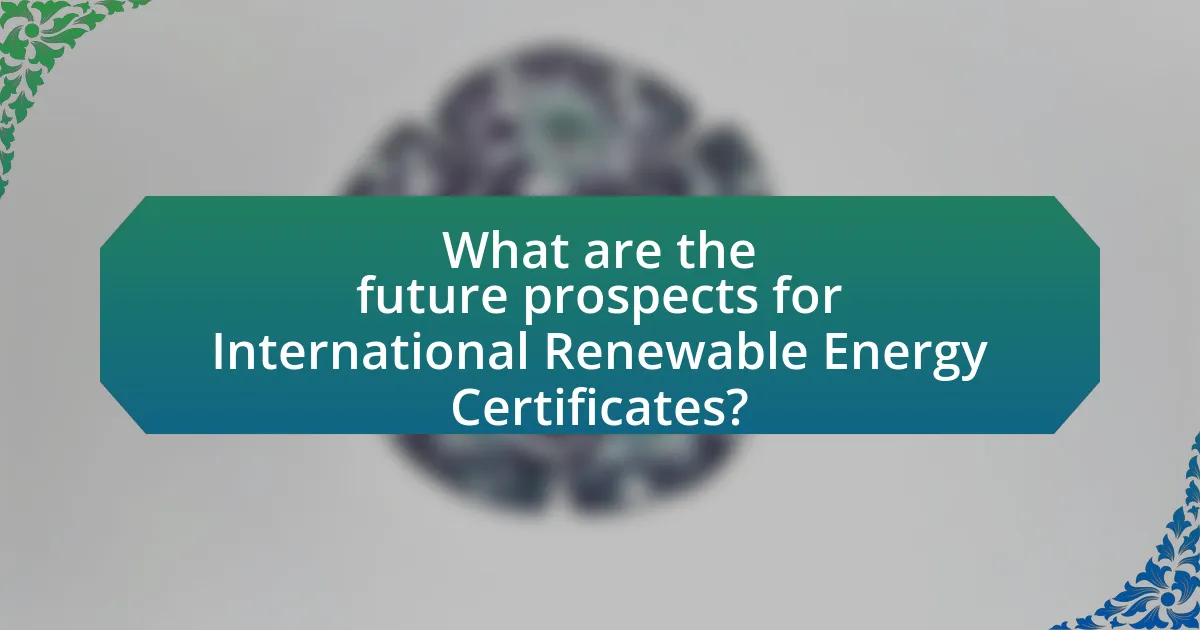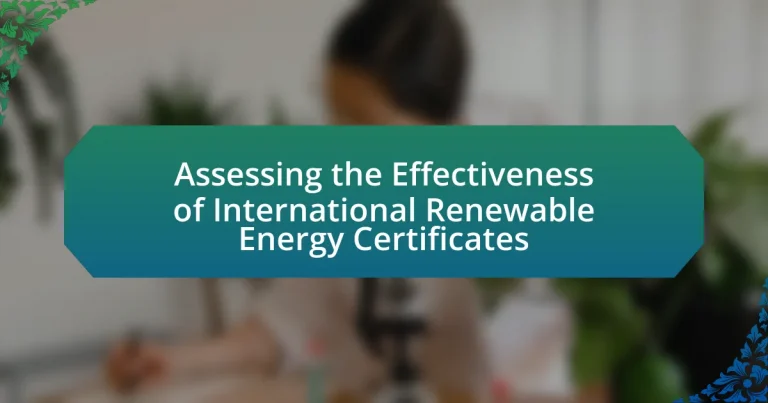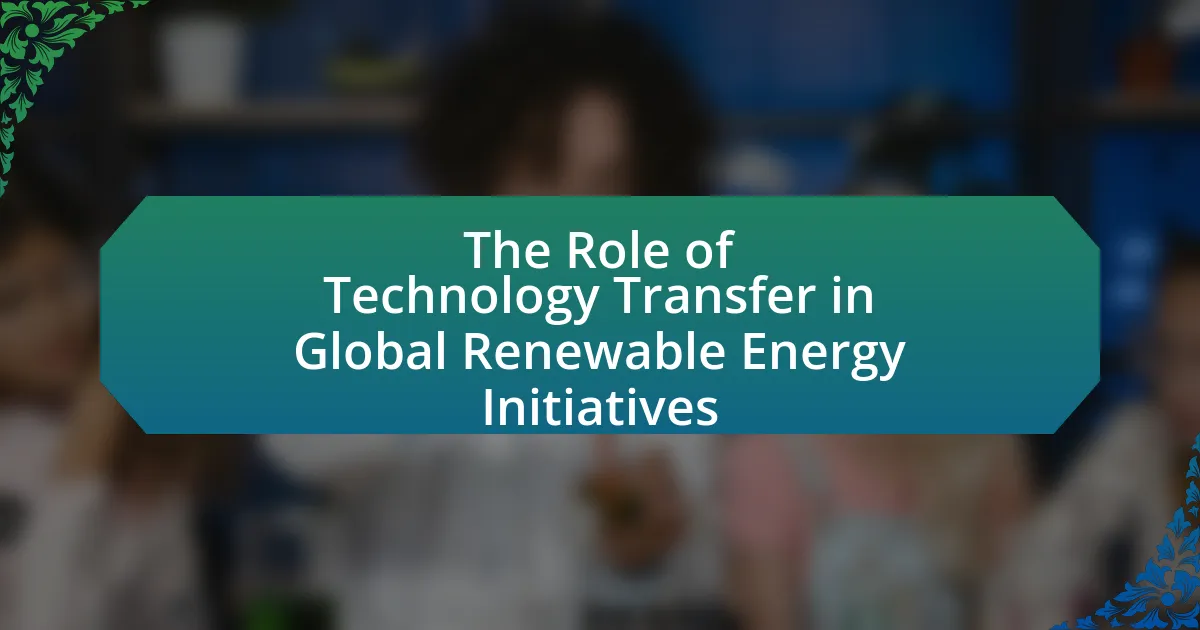International Renewable Energy Certificates (IRECs) are tradable certificates that verify the generation of one megawatt-hour (MWh) of renewable energy, facilitating international tracking and trading. This article assesses the effectiveness of IRECs in promoting renewable energy adoption, examining their role in carbon offsetting, compliance with sustainability goals, and the challenges they face, such as transparency and market integrity. Key components of IRECs, their interaction within the renewable energy market, and emerging trends that could influence their future effectiveness are also discussed, alongside criticisms and suggested improvements for enhancing their credibility and impact.

What are International Renewable Energy Certificates?
International Renewable Energy Certificates (IRECs) are tradable certificates that represent proof that one megawatt-hour (MWh) of renewable energy has been generated and fed into the electricity grid. IRECs facilitate the tracking and trading of renewable energy generation across international borders, enabling countries and companies to meet renewable energy targets and commitments. The issuance of IRECs is often governed by specific standards and regulations, ensuring that the renewable energy claimed is verifiable and corresponds to actual generation.
How do International Renewable Energy Certificates function?
International Renewable Energy Certificates (IRECs) function as tradable commodities that represent proof that one megawatt-hour (MWh) of renewable energy has been generated and fed into the electricity grid. Each certificate is issued for renewable energy generation from sources such as wind, solar, or hydroelectric power, and it serves to track and verify the production of renewable energy.
IRECs enable organizations and individuals to claim the environmental benefits associated with renewable energy generation, even if they do not directly consume that energy. This system supports the transition to renewable energy by providing a financial incentive for producers and allowing buyers to meet regulatory requirements or corporate sustainability goals. The effectiveness of IRECs is evidenced by their role in promoting investment in renewable energy projects, as they create a market for renewable energy that can drive down costs and increase deployment.
What are the key components of International Renewable Energy Certificates?
The key components of International Renewable Energy Certificates (IRECs) include the certificate’s unique identification number, the type of renewable energy source, the amount of energy generated, the date of generation, and the location of the generation facility. Each IREC serves as a proof that a specific amount of renewable energy has been produced and fed into the grid, facilitating the tracking and trading of renewable energy across borders. This system is essential for promoting renewable energy use and ensuring compliance with international sustainability goals.
How do these components interact within the renewable energy market?
The components of the renewable energy market, including producers, consumers, regulatory bodies, and international renewable energy certificates (IRECs), interact through a system of incentives and compliance mechanisms. Producers generate renewable energy and can sell IRECs to demonstrate their contribution to sustainability, while consumers, including businesses and governments, purchase these certificates to meet regulatory requirements or corporate sustainability goals. Regulatory bodies establish the frameworks that govern the issuance and trading of IRECs, ensuring that the market operates transparently and efficiently. This interaction fosters a marketplace where renewable energy generation is incentivized, leading to increased investment and innovation in the sector. For instance, as of 2021, the global market for IRECs was valued at approximately $1.5 billion, reflecting the growing demand for renewable energy solutions and compliance with international climate agreements.
What is the purpose of International Renewable Energy Certificates?
The purpose of International Renewable Energy Certificates (IRECs) is to provide a market-based mechanism for tracking and verifying the generation of renewable energy. IRECs serve as proof that a specific amount of renewable energy has been produced and can be traded to help organizations meet renewable energy targets or regulatory requirements. This system supports the growth of renewable energy markets by enabling transparency and accountability, thereby encouraging investment in renewable energy projects.
How do International Renewable Energy Certificates promote renewable energy usage?
International Renewable Energy Certificates (IRECs) promote renewable energy usage by providing a market-based mechanism that incentivizes the generation of renewable energy. IRECs represent proof that one megawatt-hour of renewable energy has been produced and fed into the grid, allowing producers to sell these certificates to entities seeking to offset their carbon emissions. This creates a financial incentive for energy producers to invest in renewable technologies, as they can generate additional revenue through the sale of IRECs. According to the International Renewable Energy Agency, the global market for renewable energy certificates has grown significantly, indicating increased investment and interest in renewable energy sources.
What role do they play in carbon offsetting and emissions trading?
International Renewable Energy Certificates (IRECs) play a crucial role in carbon offsetting and emissions trading by providing a mechanism for tracking and verifying renewable energy generation. IRECs enable entities to claim the environmental benefits associated with renewable energy production, thus allowing them to offset their carbon emissions. For instance, each certificate represents one megawatt-hour of renewable energy generated, which can be traded in emissions markets. This trading incentivizes the development of renewable energy projects, as demonstrated by the growth of the global carbon market, which was valued at approximately $272 billion in 2020, according to the World Bank. By facilitating the exchange of IRECs, emissions trading systems can effectively reduce overall greenhouse gas emissions while promoting investment in sustainable energy sources.

How effective are International Renewable Energy Certificates in achieving their goals?
International Renewable Energy Certificates (IRECs) are effective in promoting renewable energy adoption and tracking progress towards sustainability goals. They facilitate the trade of renewable energy attributes, enabling organizations to claim the use of renewable energy and support the transition to a low-carbon economy. According to the International Renewable Energy Agency (IRENA), the use of IRECs has led to increased investments in renewable energy projects, with a reported growth of 20% in global renewable energy capacity in 2020 alone. This demonstrates that IRECs play a significant role in incentivizing renewable energy generation and consumption, thereby contributing to climate change mitigation efforts.
What metrics are used to assess the effectiveness of International Renewable Energy Certificates?
The effectiveness of International Renewable Energy Certificates (IRECs) is assessed using several key metrics, including the volume of certificates issued, the percentage of renewable energy generation, and the impact on greenhouse gas emissions reduction. The volume of certificates issued indicates the scale of renewable energy projects and their contribution to energy markets. The percentage of renewable energy generation reflects the actual share of renewables in the energy mix, which is crucial for evaluating progress towards sustainability goals. Additionally, measuring the reduction in greenhouse gas emissions provides a direct link between IRECs and environmental benefits, demonstrating their role in combating climate change. These metrics collectively offer a comprehensive view of the effectiveness of IRECs in promoting renewable energy adoption and achieving environmental objectives.
How do these metrics reflect the impact on renewable energy generation?
Metrics such as renewable energy generation capacity, carbon emissions reduction, and energy efficiency directly reflect the impact on renewable energy generation. For instance, an increase in renewable energy generation capacity indicates a higher contribution to the energy mix, which is essential for reducing reliance on fossil fuels. According to the International Renewable Energy Agency (IRENA), global renewable energy capacity reached 2,799 gigawatts in 2020, showcasing significant growth and its role in mitigating climate change. Additionally, metrics that track carbon emissions reductions provide insight into the effectiveness of renewable energy in lowering greenhouse gas emissions, with studies showing that renewable energy sources can reduce emissions by up to 70% compared to traditional energy sources. These metrics collectively demonstrate the tangible benefits and progress of renewable energy initiatives.
What challenges exist in measuring the effectiveness of International Renewable Energy Certificates?
Measuring the effectiveness of International Renewable Energy Certificates (IRECs) faces several challenges, primarily due to issues of transparency, standardization, and market integrity. Transparency is often lacking, making it difficult to verify the actual renewable energy generation associated with each certificate. Additionally, the absence of standardized metrics across different regions complicates comparisons and assessments of effectiveness. Market integrity is also a concern, as the potential for double counting or fraudulent certificates undermines the credibility of the system. According to a report by the International Renewable Energy Agency, these challenges can lead to discrepancies in reported renewable energy contributions, ultimately affecting policy decisions and investment in renewable technologies.
What are the criticisms of International Renewable Energy Certificates?
International Renewable Energy Certificates (IRECs) face several criticisms, primarily regarding their effectiveness in promoting genuine renewable energy generation. Critics argue that IRECs can lead to greenwashing, where companies purchase certificates to claim renewable energy use without making substantial changes to their energy sourcing. Additionally, the lack of standardized regulations across different countries can result in inconsistencies in how certificates are issued and traded, undermining their credibility. Furthermore, some studies indicate that the market for IRECs may not accurately reflect the actual increase in renewable energy capacity, as purchasing certificates does not necessarily correlate with new renewable energy projects being developed. These criticisms highlight concerns about the integrity and impact of IRECs in driving the transition to sustainable energy.
How do critics argue that International Renewable Energy Certificates may fail to incentivize real change?
Critics argue that International Renewable Energy Certificates (IRECs) may fail to incentivize real change due to their potential for enabling “greenwashing,” where companies purchase certificates to claim renewable energy usage without making substantial changes to their energy practices. This criticism is supported by studies indicating that many organizations rely on IRECs to meet sustainability goals while continuing to use fossil fuels, thereby undermining the intended impact of promoting genuine renewable energy adoption. Additionally, the lack of stringent verification processes for IREC transactions raises concerns about the authenticity of the claimed renewable energy contributions, further questioning the effectiveness of IRECs in driving meaningful environmental progress.
What alternative approaches are suggested by critics?
Critics suggest several alternative approaches to International Renewable Energy Certificates (IRECs), including direct government subsidies for renewable energy projects, carbon pricing mechanisms, and investment in energy efficiency technologies. These alternatives aim to provide more immediate financial support and incentives for renewable energy development, potentially leading to faster adoption and greater overall impact on reducing carbon emissions. For instance, direct subsidies can lower the cost barrier for renewable energy projects, while carbon pricing can create a financial incentive for reducing greenhouse gas emissions.

What are the future prospects for International Renewable Energy Certificates?
The future prospects for International Renewable Energy Certificates (IRECs) are promising, driven by increasing global demand for renewable energy and regulatory frameworks supporting carbon neutrality. As countries commit to net-zero emissions targets, the role of IRECs in facilitating renewable energy trading and compliance with environmental regulations is expected to expand significantly. For instance, the International Energy Agency projects that renewable energy capacity will grow by over 50% by 2025, enhancing the relevance of IRECs in tracking and verifying renewable energy generation. Additionally, the establishment of standardized certification processes and market mechanisms will likely improve the credibility and marketability of IRECs, further solidifying their position in the global energy landscape.
How might policy changes affect the effectiveness of International Renewable Energy Certificates?
Policy changes can significantly impact the effectiveness of International Renewable Energy Certificates (IRECs) by altering regulatory frameworks, market dynamics, and compliance mechanisms. For instance, stricter renewable energy targets or enhanced incentives for renewable energy adoption can increase demand for IRECs, thereby enhancing their market value and effectiveness in promoting renewable energy generation. Conversely, the introduction of subsidies for fossil fuels or a lack of enforcement of renewable energy mandates can diminish the perceived value of IRECs, leading to reduced investment in renewable energy projects. Historical data shows that countries with robust renewable energy policies, such as Germany and Denmark, have seen a marked increase in renewable energy capacity, correlating with the effectiveness of their IREC systems.
What trends are emerging in the global renewable energy market that could influence International Renewable Energy Certificates?
Emerging trends in the global renewable energy market that could influence International Renewable Energy Certificates (IRECs) include the increasing adoption of decentralized energy systems, advancements in energy storage technologies, and heightened regulatory frameworks promoting sustainability. Decentralized energy systems, such as microgrids and community solar projects, enable localized energy production and consumption, which can enhance the demand for IRECs as they facilitate tracking and trading of renewable energy generation.
Advancements in energy storage technologies, particularly lithium-ion batteries, are improving the reliability and efficiency of renewable energy sources, making them more competitive with fossil fuels. This shift can lead to a greater issuance of IRECs as more renewable energy becomes available for certification.
Additionally, regulatory frameworks are evolving globally, with countries implementing stricter emissions targets and renewable energy mandates. For instance, the European Union’s Green Deal aims for a 55% reduction in greenhouse gas emissions by 2030, which could drive demand for IRECs as businesses and governments seek to demonstrate compliance with these targets. These trends collectively indicate a growing market for IRECs, driven by technological advancements and regulatory pressures.
What best practices can enhance the effectiveness of International Renewable Energy Certificates?
Implementing robust tracking and verification systems enhances the effectiveness of International Renewable Energy Certificates (IRECs). Accurate tracking ensures that each certificate corresponds to a specific amount of renewable energy generated, preventing double counting and fraud. For instance, the International Renewable Energy Agency (IRENA) emphasizes the importance of transparent registries that provide real-time data on renewable energy production and certificate issuance. Additionally, harmonizing standards across countries can facilitate cross-border trading of IRECs, increasing market efficiency and liquidity. Research by the World Bank indicates that standardized frameworks can lead to a 30% increase in market participation, thereby boosting the overall impact of IRECs in promoting renewable energy adoption.
How can stakeholders collaborate to improve the credibility of International Renewable Energy Certificates?
Stakeholders can collaborate to improve the credibility of International Renewable Energy Certificates (IRECs) by establishing standardized verification processes and enhancing transparency in the issuance and trading of these certificates. Collaborative efforts can include creating a unified framework for third-party audits, which would ensure that renewable energy generation claims are accurate and verifiable. For instance, the International Renewable Energy Agency (IRENA) has advocated for harmonized standards that can facilitate cross-border recognition of IRECs, thereby increasing trust among market participants. Additionally, stakeholders can share data and best practices through industry forums and partnerships, which can lead to improved methodologies for tracking renewable energy production and consumption. This collective approach not only strengthens the integrity of IRECs but also fosters greater investor confidence and market participation.
What strategies can be implemented to increase transparency and trust in the system?
Implementing third-party verification and certification processes can significantly increase transparency and trust in the system of International Renewable Energy Certificates (IRECs). Third-party organizations, such as the International Organization for Standardization (ISO), can audit and verify the issuance and trading of IRECs, ensuring that the certificates represent genuine renewable energy generation. This approach has been shown to enhance credibility, as evidenced by the success of similar verification systems in other sectors, such as carbon credits, where independent audits have led to increased stakeholder confidence and participation. Additionally, establishing a publicly accessible registry that tracks the lifecycle of each certificate from issuance to retirement can further bolster transparency, allowing stakeholders to verify claims and fostering trust in the integrity of the system.




